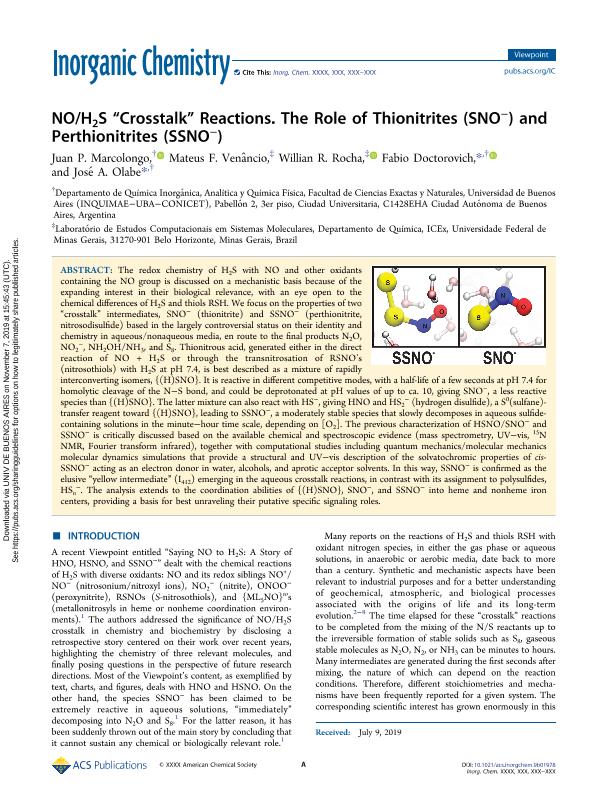Mostrar el registro sencillo del ítem
dc.contributor.author
Marcolongo, Juan Pablo

dc.contributor.author
Venâncio, Mateus F.
dc.contributor.author
Rocha, Willian R.
dc.contributor.author
Doctorovich, Fabio

dc.contributor.author
Olabe Iparraguirre, Jose Antonio

dc.date.available
2021-01-26T12:43:32Z
dc.date.issued
2019-11
dc.identifier.citation
Marcolongo, Juan Pablo; Venâncio, Mateus F.; Rocha, Willian R.; Doctorovich, Fabio; Olabe Iparraguirre, Jose Antonio; NO/H2S "crosstalk" Reactions. The Role of Thionitrites (SNO-) and Perthionitrites (SSNO-); American Chemical Society; Inorganic Chemistry; 58; 22; 11-2019; 14981-14997
dc.identifier.issn
0020-1669
dc.identifier.uri
http://hdl.handle.net/11336/123684
dc.description.abstract
The redox chemistry of H2S with NO and other oxidants containing the NO group is discussed on a mechanistic basis because of the expanding interest in their biological relevance, with an eye open to the chemical differences of H2S and thiols RSH. We focus on the properties of two "crosstalk" intermediates, SNO- (thionitrite) and SSNO- (perthionitrite, nitrosodisulfide) based in the largely controversial status on their identity and chemistry in aqueous/nonaqueous media, en route to the final products N2O, NO2 -, NH2OH/NH3, and S8. Thionitrous acid, generated either in the direct reaction of NO + H2S or through the transnitrosation of RSNO's (nitrosothiols) with H2S at pH 7.4, is best described as a mixture of rapidly interconverting isomers, {(H)SNO}. It is reactive in different competitive modes, with a half-life of a few seconds at pH 7.4 for homolytic cleavage of the N-S bond, and could be deprotonated at pH values of up to ca. 10, giving SNO-, a less reactive species than {(H)SNO}. The latter mixture can also react with HS-, giving HNO and HS2 - (hydrogen disulfide), a S0(sulfane)-transfer reagent toward {(H)SNO}, leading to SSNO-, a moderately stable species that slowly decomposes in aqueous sulfide-containing solutions in the minute-hour time scale, depending on [O2]. The previous characterization of HSNO/SNO- and SSNO- is critically discussed based on the available chemical and spectroscopic evidence (mass spectrometry, UV-vis, 15N NMR, Fourier transform infrared), together with computational studies including quantum mechanics/molecular mechanics molecular dynamics simulations that provide a structural and UV-vis description of the solvatochromic properties of cis-SSNO- acting as an electron donor in water, alcohols, and aprotic acceptor solvents. In this way, SSNO- is confirmed as the elusive "yellow intermediate" (I412) emerging in the aqueous crosstalk reactions, in contrast with its assignment to polysulfides, HSn -. The analysis extends to the coordination abilities of {(H)SNO}, SNO-, and SSNO- into heme and nonheme iron centers, providing a basis for best unraveling their putative specific signaling roles.
dc.format
application/pdf
dc.language.iso
eng
dc.publisher
American Chemical Society

dc.rights
info:eu-repo/semantics/openAccess
dc.rights.uri
https://creativecommons.org/licenses/by-nc-sa/2.5/ar/
dc.subject
nitric oxide
dc.subject
H2S
dc.subject
nitroxyl
dc.subject
crosstalk
dc.subject.classification
Química Inorgánica y Nuclear

dc.subject.classification
Ciencias Químicas

dc.subject.classification
CIENCIAS NATURALES Y EXACTAS

dc.title
NO/H2S "crosstalk" Reactions. The Role of Thionitrites (SNO-) and Perthionitrites (SSNO-)
dc.type
info:eu-repo/semantics/article
dc.type
info:ar-repo/semantics/artículo
dc.type
info:eu-repo/semantics/publishedVersion
dc.date.updated
2020-11-20T14:43:14Z
dc.journal.volume
58
dc.journal.number
22
dc.journal.pagination
14981-14997
dc.journal.pais
Estados Unidos

dc.description.fil
Fil: Marcolongo, Juan Pablo. Consejo Nacional de Investigaciones Científicas y Técnicas. Oficina de Coordinación Administrativa Ciudad Universitaria. Instituto de Química, Física de los Materiales, Medioambiente y Energía. Universidad de Buenos Aires. Facultad de Ciencias Exactas y Naturales. Instituto de Química, Física de los Materiales, Medioambiente y Energía; Argentina
dc.description.fil
Fil: Venâncio, Mateus F.. Universidade Federal de Minas Gerais; Brasil
dc.description.fil
Fil: Rocha, Willian R.. Universidade Federal de Minas Gerais; Brasil
dc.description.fil
Fil: Doctorovich, Fabio. Consejo Nacional de Investigaciones Científicas y Técnicas. Oficina de Coordinación Administrativa Ciudad Universitaria. Instituto de Química, Física de los Materiales, Medioambiente y Energía. Universidad de Buenos Aires. Facultad de Ciencias Exactas y Naturales. Instituto de Química, Física de los Materiales, Medioambiente y Energía; Argentina
dc.description.fil
Fil: Olabe Iparraguirre, Jose Antonio. Consejo Nacional de Investigaciones Científicas y Técnicas. Oficina de Coordinación Administrativa Ciudad Universitaria. Instituto de Química, Física de los Materiales, Medioambiente y Energía. Universidad de Buenos Aires. Facultad de Ciencias Exactas y Naturales. Instituto de Química, Física de los Materiales, Medioambiente y Energía; Argentina
dc.journal.title
Inorganic Chemistry

dc.relation.alternativeid
info:eu-repo/semantics/altIdentifier/url/https://pubs.acs.org/doi/10.1021/acs.inorgchem.9b01978
dc.relation.alternativeid
info:eu-repo/semantics/altIdentifier/doi/http://dx.doi.org/10.1021/acs.inorgchem.9b01978
Archivos asociados
